Jefferson Bass's Blog, page 3
April 16, 2012
Gone Roadtrippin' : Blog & Book Tour 2012!
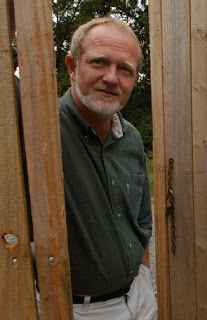 If you’ve been lurking around the blog lately, you may have noticed that no one's been home for a few days—weeds sprouting up in the flowerbeds, the mailbox bulging. Don’t worry, though. We didn’t intend to pack up and ride out without leaving a little note.
If you’ve been lurking around the blog lately, you may have noticed that no one's been home for a few days—weeds sprouting up in the flowerbeds, the mailbox bulging. Don’t worry, though. We didn’t intend to pack up and ride out without leaving a little note.In anticipation of the May 8, 2012 release of The Inquisitor’s Key , I've decided to embark on a tour across the blogosphere...before I leave for the continental United States book tour. I'm nailing this note to the outside of the (virtual) Body Farm gate: an invitation to each and every one of you.
Meet up with us on The Inquisitor’s Key Blog Tour 2012—without even leaving your chair!—and then find us on The Inquisitor’s Key Book Tour 2012 in a city near you. On the blog tour, not only will you have the opportunity to go behind the scenes of the new Body Farm novel, but you’ll get inside access to exclusive interviews, book reviews, and book giveaway contests. On the book tour, you’ll be able to meet us—Jon Jefferson and Dr. Bass, the men behind the mysteries of Jefferson Bass—and pick up a signed copy (or two..or ten) of The Inquisitor’s Key.
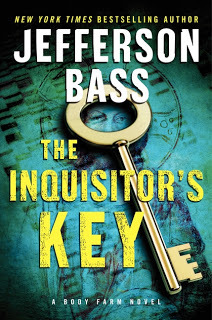
Calendar of Blog-Tour Events
I’d be honored, dear readers, if you'd leave comments on the guest blog posts below in support of Jefferson Bass, the Body Farm series, and The Inquisitor’s Key! We're trying to get the word out to those who are not familiar—yet—with the Body Farm novels and the great work being done at the Body Farm, but we need your help. Visit these blogs in April and May and show readers that Jefferson Bass has the most diehard fans of all. Tell the world to read The Inquisitor’s Key!
April 7, 2012 – Guest post @ My Bookish WaysApril 9, 2012 – Guest post @ Book Bitch BlogApril 11, 2012 – Review of The Inquisitor’s Key @ Chaotic CompendiumsApril 17, 2012 – Guest post @ The Writing LifeApril 17, 2012: Review of The Inquisitor's Key @ Jenn's Bookshelves
April 20, 2012: Guest post @ SHOTS Crime & Thriller Ezine
April 23, 2012: Review of The Inquisitor's Key @ Book Reviews by Elizabeth A. White
April 24, 2012: Guest post @ Skeleton Keys
April 25, 2012: Q&A @ Writerhead
April 27, 2012: Guest post @ Indigo Fiction Blog
April 28, 2012: Guest post @ Author's Corner
April 29, 2012: Guest post @ Gladiator's Pen
April 30, 2012: Guest post @ The Quivering Pen
May 2, 2012: Guest post @ Poe's Deadly Daughters
May 3, 2012: Guest post @ The Divining Wand
May 4, 2012: Q&A @ Julianna Baggott's Blog
May 5, 2012: Guest post @ Putting Words Down on Paper
May 6, 2012: Guest post @ BookPeople's Blog
May 8, 2012: Guest post @ CrimeSpree Magazine
May 8, 2012: Guest post @ The Book Case
May 9, 2012: Guest post @ Crime Fiction Collective
May 9, 2012: Review of The Inquisitor's Key @ Dew on the Kudzu
May 10, 2012: Guest post @ The Writer's Forensics Blog
May 11, 2012: Review of The Inquisitor's Key @ Luxury Reading
May 11, 2012: Q&A @ Mystery Tribune
May 15, 2012: Guest post @ Pattinase
Calendar of Book-Tour Events
If you’re planning to attend one of our book-tour events this year, please click the appropriate event link below, then JOIN the event on Facebook so we know how many to expect at the party! We want to see YOU in the crowd. Please comment at the end of this post as well to let everyone know which event you’ll be attending. Let's see a show of hands!
1. A Private Event in Knoxville, TennesseeFarragut Chamber of Commerce12284 North Fox Den DriveKnoxville, TennesseeMay 8, 2012 at 7:30 a.m. – 10:30 a.m.2. Fundraising Benefit in Oak Ridge, TennesseeNew Hope Center602 Scarboro RoadOak Ridge, TennesseeTuesday -- May 8, 2012 at 7:00 p.m.Purchase tickets to this benefit here.3. Jefferson Bass in Scottsdale, ArizonaPoisoned Pen4014 N. Goldwater BlvdScottsdale, Arizona 85251 Wednesday -- May 9, 2012 at 7:00 p.m. 4. Jefferson Bass in Woodstock, GeorgiaFox Tale Book Shoppe105 E. Main St. Woodstock, GeorgiaThursday -- May 10, 2012 at 7:00 p.m.5. Lunch with Jefferson Bass in Decatur, GeorgiaCapozzi’s Decatur1355 Clairmont RoadDecatur, Georgia 30033Friday – May 11, 2012 at noon – 3:00 p.m.6. Jefferson Bass in Huntsville, AlabamaHuntsville Madison County Public Library915 Monroe St. Huntsville, Alabama 35801Friday – May 11, 2012 at 7:00p.m.7. Jefferson Bass in Nashville, TennesseeParnassus Books3900 Hillsboro PikeNashville, Tennessee 37215Saturday – May 12, 2012 at 4:00 p.m.8. Jefferson Bass in Knoxville, TennesseeKroger11244 Kingston PikeKnoxville, TennesseeSunday – May 13, 2012 at 3:00 p.m. 9. Jefferson Bass in Knoxville, Tennessee (2nd appearance)Books-A-Million8513 Kingston PikeKnoxville, Tennessee 37919Sunday – May 13, 2012 at 6:30 p.m.10. Jefferson Bass in Maryville, TennesseeHastings501 N. Foothills Plaza DriveMaryville, Tennessee 37801Monday – May 14, 2012 at 6:00 p.m.11. Jefferson Bass in Coral Gables, FloridaBooks & Books265 Aragon Ave.Coral Gables, Florida 33134Tuesday – May 15, 2012 at 8:00 p.m.12. Jefferson Bass in Vero Beach, FloridaThe Vero Beach Book Center2145 Indian River Blvd.Vero Beach, Florida 32960Wednesday – May 16, 2012 at 6:00 p.m.13. Jefferson Bass in Tallahassee, FloridaBooks-A-Million3531 Thomasville RoadTallahassee, Florida 32309Saturday – May 19, 2012 at 2:00 p.m.
Published on April 16, 2012 17:29
March 23, 2012
High-Noon Showdown -- Win a signed copy of "The Bone Yard"
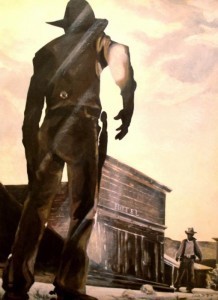 Howdy! I reckon you've come to join the high-noon showdown. The way I see it, the more the merrier when it comes to gunslingin'. Now before you get to scratchin' your itchy trigger finger, take a seat and hear me out. But -- for the love of Pete -- don't sit on that cactus.
Howdy! I reckon you've come to join the high-noon showdown. The way I see it, the more the merrier when it comes to gunslingin'. Now before you get to scratchin' your itchy trigger finger, take a seat and hear me out. But -- for the love of Pete -- don't sit on that cactus. In anticipation of the March 27, 2012 paperback release of The Bone Yard, Mr. Bones is giving away signed copies of the novel. To make this fun instead of dangerous, I'm suggesting that we all set aside our six-shooters and draw from a different sort of holster, the holster of memory.
The rules of the showdown are simple. This is your chance to become the storyteller at the side of our virtual campfire. What do I mean? In the COMMENTS section of this blog entry, I want you to let loose and draw from your holster of memory. Tell us a story.
Here are examples of what will qualify you as an entrant to the giveaway contest: 1.) Share your favorite book in the Body Farm series and explain why. 2.) Tell us about an encounter with Jefferson Bass, whether at a signing or somewhere else. 3.) Post a photo of yourself with Jefferson Bass, or of you holding a Body Farm novel, on our Facebook page so we can proudly display it. 4.) Get creative and surprise us: fan fiction, anyone? 5.) Tell us anything you'd want to tell us if we were standing before you in a dusty Wild West street at high noon. . . and you were down to your last bullet.
Do we have an understanding? Don't forget to sign your comment with your name so that your name is entered into the contest! Then -- write an e-mail (with your name) to JeffersonBassBookGiveaway@hotmail.com to let us know that you should WIN!
By sundown on Sunday (3/25/2012), the winner'll be the last one standing. Now: turn on your heel and walk fifteen paces. Ready? Set. . . Draw!
Published on March 23, 2012 09:02
High-Noon Showdown -- or: Throw-a-Fan-a-Bone-Day!
 Howdy! I reckon you've come to join the high-noon showdown. The way I see it, the more the merrier when it comes to gunslingin'. Now before you get to scratchin' your itchy trigger finger, take a seat and hear me out. But -- for the love of Pete -- don't sit on that cactus.
Howdy! I reckon you've come to join the high-noon showdown. The way I see it, the more the merrier when it comes to gunslingin'. Now before you get to scratchin' your itchy trigger finger, take a seat and hear me out. But -- for the love of Pete -- don't sit on that cactus. In anticipation of the March 27, 2012 paperback release of The Bone Yard, Mr. Bones is giving away signed copies of the novel. To make this fun instead of dangerous, I'm suggesting that we all set aside our six-shooters and draw from a different sort of holster, the holster of memory.
The rules of the showdown are simple. This is your chance to become the storyteller at the side of our virtual campfire. What do I mean? In the COMMENTS section of this blog entry, I want you to let loose and draw from your holster of memory. Tell us a story.
Here are examples of what will qualify you as an entrant to the giveaway contest: 1.) Share your favorite book in the Body Farm series and explain why. 2.) Tell us about an encounter with Jefferson Bass, whether at a signing or somewhere else. 3.) Post a photo of yourself with Jefferson Bass, or of you holding a Body Farm novel, on our Facebook page so we can proudly display it. 4.) Get creative and surprise us: fan fiction, anyone? 5.) Tell us anything you'd want to tell us if we were standing before you in a dusty Wild West street at high noon. . . and you were down to your last bullet.
Do we have an understanding? Don't forget to sign your comment with your name so that your name is entered into the contest! Then -- write an e-mail (with your name) to JeffersonBassBookGiveaway@hotmail.com to let us know that you should WIN!
By sundown on Sunday (3/25/2012), the winner'll be the last one standing. Now: turn on your heel and walk fifteen paces. Ready? Set. . . Draw!
Published on March 23, 2012 09:02
March 19, 2012
"The Bone Yard" Book Giveaway
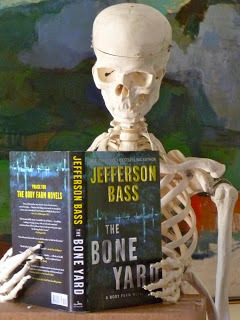 Mr. Bones has agreed to host a few book-giveaway contests here on the blog in March and April. We'll be giving away copies of The Inquisitor's Key in the coming weeks, so check back as often as humanly possible without becoming completely obsessed...
Mr. Bones has agreed to host a few book-giveaway contests here on the blog in March and April. We'll be giving away copies of The Inquisitor's Key in the coming weeks, so check back as often as humanly possible without becoming completely obsessed...Today, however, in anticipation of the paperback release of The Bone Yard on March 27, 2012, Mr. Bones will give away his beloved copy of the novel to one aspiring sleuth! I promise you one thing -- it's not going to be easy to win. In fact, it might become downright dangerous. So-- do you think you have what it takes to win this literary treasure hunt?
Rules of Participation:
1. LIKE Jefferson Bass on Facebook if you haven't already.
2. SHARE Jefferson Bass on your Facebook Wall for your friends to see. Include a variation of this message: Please LIKE this page so I can win The Bone Yard!
3. Read the following excerpt from The Bone Yard. Answer the questions that follow, then send your answers and your name as it appears on Facebook to JeffersonBassBookGiveaway@hotmail.com
4. Then post a comment -- anything you want -- on this blog entry so we have a tally of contestants.
Pretty simple, right? Thanks for playing along, and good luck! The randomly selected winner(s?) will be announced tomorrow!
Chattering voices floated up the hillside, growing louder as the people came closer. If I didn't hurry, I'd be caught with the skull in my hand. Still I hesitated, turning the cranium rightside-up for one last look into the vacant eye orbits. What did I hope to see there—what meaning did I think I might find—in those empty sockets? Maybe nothing. Maybe only the emptiness itself.
As the voices drew nearer, I finally forced myself to act, to choose. I tucked the skull under the edge of a fallen oak tree, piling dead leaves against the trunk as camouflage. Then a worry popped into my head: Is the pile of leaves too obvious, a giveaway? But it was too late to second-guess myself; I'd run out of time, and the makeshift hiding place would have to do.
Stepping over the tree, I strolled downhill toward the cluster of people approaching. I feigned nonchalance, resisting the urge to glance back and check for visible bones. A woman at the front of the group—a thirty-something blond with the energetic, outdoorsy look of a runner or a cyclist—stopped in her tracks and looked at me. Her eyes bored into mine, and I wondered what she saw there. I tried to make my face as blank and unenlightening as the skull's had been.
She shifted her gaze to the wooded slope behind me. Her eyes scanned the forest floor, then settled on the fallen tree. Walking slowly toward it, she leaned down, studied both sides, and then brushed at the leaves I'd piled on the uphill side. "There's a skull beside this log," she announced to the group. She said it as coolly as if it were an everyday occurrence, finding a skull in the woods.
"Wow," said a young red-haired woman in a black jumpsuit. "Police, one; Brockton, zero. If Dr. B decides to turn killer, he'd better steer clear of Florida."
The redheaded smart-aleck was Miranda Lovelady, my graduate assistant. The blond who'd found the skull so swiftly was Angie St. Claire, a forensic analyst from the Florida state crime lab. Angie, along with the 23 other people in the group Miranda had brought up the trail, had spent the past ten weeks as a student at the National Forensic Academy, a joint venture of the University of Tennessee and the Knoxville Police Department. Taught by experts in ballistics, fingerprinting, trace evidence, DNA, anthropology, and other forensic specialties, the NFA training culminated in the two death scenes Miranda and I had staged here at the University of Tennessee's Anthropological Research Facility: the Body Farm.
The Body Farm was perched on a hillside high above the Tennessee River. Here, a mile downstream from the heart of Knoxville, more than a hundred corpses in various states of disrepair were dispersed across the facility's three fenced-in acres. Most of the bodies lay above ground, though some were buried. And in a far corner of the facility, looking like eerie sentinels standing at attention, were three nude men: not standing, actually, but hanging, suspended by the neck from wooden scaffolds. With some misgivings, we had carried out three post-mortem lynchings, so we could observe the difference in the decomposition rate when bodies decayed off the ground, where they were less accessible to insects. We'd hung the three in the most isolated part of the facility, because important though the experiment was—the research data would help us determine time since death when a hanged body wasn't discovered for weeks or even months—the dangling corpses were a shocking sight. I'd seen them dozens of times by now, yet I still found it unnerving to round the bend in the trail and find myself confronting the trio. Their necks were stretched a few inches, their faces downcast, their arms and legs angled outward, as if accepting their grim fate with a mixture of resignation and shame. The NFA class included four African American men, and if I, a privileged white man, felt disturbed by the hanging bodies, I could scarcely imagine the complicated response the black men might feel at the sight of dangling corpses in the woods of Dixie.
Maybe I needn't have worried. Everyone in the class was a seasoned forensic professional, after all; cumulatively, the two dozen students had worked hundreds of death scenes, and some of those had probably included suicide by hanging. The students had competed fiercely to get into the NFA course, and several had told me how thrilled they were to train at the Body Farm—probably the only place on earth, after all, where cinching a noose around a neck was an act of scientific inquiry rather than of suicidal despair or racist hatred or—very rarely—state-administered execution. Here at the Body Farm, as nowhere else on earth, we could replicate death scenes with utter authenticity, even lynchings or mass murders. This particular NFA class—one of two groups that would rotate through the course this year—included crime-scene and crime-lab specialists from as far away as the United Kingdom. They'd spend the morning recovering scattered skeletal remains and other evidence Miranda and I had planted in this part of the woods. After a quick picnic lunch on a strip of grass outside the fence, they'd spend the afternoon locating and excavating a shallow, unmarked grave where Miranda and I had buried three fresh corpses, simulating a gang-style execution by drug traffickers.
She and I had spent the prior afternoon digging the grave and then refilling it once we'd laid the bodies in it. We'd clawed into the clearing's rocky, red-clay dirt with a Bobcat—a pint-sized bulldozer—that a local building contractor had recently donated to the Anthropology Department. The Bobcat was a useful tool; it was also—for me, a guy who'd grown up driving dump trucks at my stepdad's quarry—a fun toy.
Excavating the buried bodies in the afternoon heat was going to be sweaty, smelly work for the NFA class. Already, by midmorning, the temperature was above 80 degrees, and the humidity had topped 90 percent; by late afternoon, East Tennessee would feel like the tropics. Divide the year's 365 days by the number of seasons, and you might think there'd be four seasons of 91.25 days apiece, each season serenely easing its way into the next. Not this year in Knoxville; not on this steamy, smelly day in mid May.
My own body was doubtless contributing a bit to the scent wafting across the hillside, and not as pleasantly as the honeysuckle was. Like Miranda, I wore an official-looking black jumpsuit, the shoulders trimmed with the skull-adorned patches of the Forensic Anthropology Center. The jumpsuits looked cool, as in stylish, but they were woven of Nomex, a flameproof fiber that, ironically, made them hotter than hell. Despite the heat, Miranda and I had suited up to give the training exercise a more authentic look—and to let the trainees know we took them seriously.
The forensic techs weren't exactly dressed for cool comfort, either. Over their clothes they'd donned white biohazard coveralls made of Tyvek, the slippery, indestructible stuff of FedEx envelopes. Tyvek was feather-light, but I knew from experience that it didn't breathe worth a damn. As the techs knelt, stooped, squatted, and crawled their way up the hillside, setting numbered evidence markers beside the bones and artifacts they found, I could hear, or at least imagined I could hear, the steady patter of droplets on dry leaves: droplets not of rain, but of sweat. If this were an actual crime scene, they'd need to be concerned about contaminating the bones with their own sweaty DNA. I made a mental note to mention that to them once they'd rounded up all the bones. Did the glamorous stars of "CSI" and "Bones" ever shed buckets of perspiration, ever rain monsoons of sweat?
# # #After an hour of searching, the hillside bristled with numbered evidence markers—87 of them— flagging the sundry bones, beer bottles, cigarette butts, and gum wrappers Miranda and I had strewn in the woods. The markers resembled the four-inch sandwich-sign numbers restaurants sometimes put on customers' tables to tell the servers which order goes to what table, and I smiled as I imagined a macabre spin on that image: "Number 87? Half-rack of ribs, easy on the bugs?"
I'd laid all the vertebrae of the spinal column close together, in anatomical order, as they might be found at an actual death scene, so those required only a single marker. Other bones, though, were dispersed more widely, simulating the way dogs or coyotes or raccoons would tend to scatter them over time. My last-minute hiding spot for the skull had actually been a logical place for it. Skulls on a slope tend to tumble or wash downhill once the mandible comes loose; that's exactly what had happened to the skull of former congressional aide Chandra Levy, who'd been murdered in the woods of a Washington, DC, park in 2001. In the case of my "victim," the fallen tree where I'd tucked his skull was lower, I now noticed, than the area where I'd scattered most of the bones. After years of death-scene searches of my own, I'd intuitively picked a natural place for the skull to end up.
The one thing the students hadn't yet found was the murder weapon. I took a sort of perverse pride in that, as I'd been careful to tuck it deep into the honeysuckle. But lunchtime was coming up fast, and they'd need the whole afternoon to excavate the mass grave. Finally, just as I was about to start offering helpful hints—"you're cold"; "getting warmer"; "really, really hot"—I noticed Angie in scan mode again, her gaze ranging just beyond the ragged circle of evidence markers. Her eyes swept past the honeysuckle thicket, then returned, and she headed toward it, like a dog on a scent. Getting warmer, I thought, but I kept quiet as she knelt at the edge of the vines and began parting the leaves carefully. "Got something here," she said, and then she laughed. "Looks like somebody takes his golf game really seriously." With that, she extricated the murder weapon. It was a golf club—a putter—and the cross-section of the club's head matched the hole in the skull perfectly: a square peg in a square hole.
The flurry of interest in Angie's find was accompanied by a series of groan-inducing golf-club murder jokes—"fore...head!"; "keep your eye on the skull"; "I told you not to cheat"; and the worst of all, "say, old chap, mind if I slay through?" The chatter was interrupted by a series of urgent beeps from Angie's direction. "Oh, crap," she said, laying the putter on the ground. She peeled off a glove and fished a cellphone from inside her coveralls. Frowning at what she read on the display, she stepped away from the group and answered the call. At first her words were too low to make out, but the tension in her voice was unmistakable, and it was rising. As the tension ratcheted up, the volume did, too. "Wait. Say that again. Kate what? ... What are you talking about? ... When? ... How? ... A shotgun? ... Bullshit. That's not possible. That is just not possible." Her eyes darted back and forth, tracking something I suspected was hundreds of miles away, at the other end of the call, and she began to pace the hillside. "Please tell me you're making this up, Ned. Please tell me this is some really, really mean joke you're playing on me. ... Please tell me you're not telling me this."
By now everyone in the group was listening, though most were careful not to look directly at Angie. Some people exchanged worried glances; others studied the ground intently, as if the particular twig or bone in front of them held the key to all meaning in the universe. "Oh, shit. Oh shit. Jesus God. ... Have you looked at flights? .... No, I'll just drive. It'll be just as fast. ... Okay, I'm leaving now." She took a few steps down the hillside, returning to where she'd found and flagged the skull. She bent and picked it up, staring into the eye orbits, exactly as I had just before hiding it. "I have to go by the hotel to grab my stuff. ... I'll be there by midnight. I'll call you from the road." She was walking toward us now, head down, still talking. "God damn that son of a bitch. ... Look, I have to go." She snapped the phone shut, shaking her head, a look of bleak dismay on her face as she walked toward Miranda and me. She didn't slow down when she reached us; she simply handed me the skull and kept walking. As she passed, she rubbed her ungloved hand across her dripping face, and I realized she was wiping away tears, not sweat. "I have to go," she said again, not looking back. Her voice sounded hollow and haunted. "I have to go."
She broke into a jog, ran out the gate of the Body Farm, and was gone.
Questions:
1. Who found the hidden skull?
2. How much land does the Body Farm cover?
3. What "murder weapon" did Dr. Brockton hide in the tangle of honeysuckle vines?
4. True or False: On the prior afternoon, Dr. Brockton buried the three fresh corpses alone.
5. Who was murdered in the woods of a park in Washington, DC in 2001?
Whew. . .wasn't that fun? Now: Send your answers and your name to JeffersonBassBookGiveaway@hotmail.com. And don't forget to leave a comment below!
Published on March 19, 2012 13:47
March 11, 2012
Get Your Popcorn & Tell Your Friends: Time to watch the video trailer! (And participate in the reader poll below. Please comment/vote!)
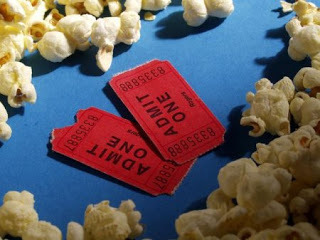 I'd planned to write this time about one of the new book's medieval characters: Petrarch, a 14th-century chaplain, poet, historian, and philosopher (a true Renaissance Man – a century before there WAS a Renaissance!) But Petrarch'll have to wait, because I'm pre-empting him to roll out the new video trailer for the book. Two trailers, actually: one for
The Inquisitor's Key
, and one for
The Bones of Avignon
, the U.K. edition. (As with the books, so with the trailers: the only difference is the title & release date. But hey, watch 'em both!)
I'd planned to write this time about one of the new book's medieval characters: Petrarch, a 14th-century chaplain, poet, historian, and philosopher (a true Renaissance Man – a century before there WAS a Renaissance!) But Petrarch'll have to wait, because I'm pre-empting him to roll out the new video trailer for the book. Two trailers, actually: one for
The Inquisitor's Key
, and one for
The Bones of Avignon
, the U.K. edition. (As with the books, so with the trailers: the only difference is the title & release date. But hey, watch 'em both!)Putting the trailers on YouTube – and linking to them on Facebook – makes me realize how fast things are changing. It's an interesting, exciting, and nail-biting time to be writing books. Bookstores are dropping like flies (three of my favorite book-tour venues died between the 2010 book tour and the 2011 book tour, alas!). E-books now outsell printed books. A big part of my "job" now involves getting smart and strategic about using Facebook and YouTube and Twitter and blogs (not just this blog, but also guest blogs, too) to connect with readers. (If Petrarch – and Gutenberg – were alive now, would they be tweeting???)
I wish I were as smart – as omniscient – as Facebook and Google and the folks who buy their data (which is to say, our data). A few days ago, the mailman delivered two startling pieces of business mail to my house. What surprised me was that they were sent not to me, but to "The Inquisitor's Key" — at my home address. My own publisher sometimes has trouble keeping track of my address, for pete's sake … and yet companies that don't know me from Adam understand that The Inquisitor's Key emanated from this address. Progress? I'm not so sure … and yet I'm delighted to reap the benefits of cyberspace & hyperlinks. And if I were savvier & richer, who knows, maybe I'd be mining Google and Facebook data to ferret out every man, woman, and child whose cookies & clicks suggest that he or she would absolutely adore the new book.
Sadly, I'm not that savvy; sadder still, I'm not that rich! So for now, I'll just keep posting blogs here and updates on Facebook. Plus tweets on Twitter (@Jefferson_Bass), starting soon, I promise/threaten (depending on your opinion of Twitter). And I'll steer everyone I can to the video trailer, which I absolutely love! (Huge shout-out here to my filmmaker friend Buck Kahler, of Nolichucky Pictures, who did a BRILLIANT job making it.) The trailer's short – 30 seconds – but it packs a lot of punch.
Who knows, maybe this short, small trailer will plant a cyber-seed – somewhere, somehow (are you listening, FB & Google?) – for a 2-hour blockbuster feature film...
After you watch the trailer, stick around for the READER POLL. Please let your voice be heard -- comment and vote for your choice. Here's the million-dollar question: Who should play Dr. Brockton -- and his intrepid assistant Miranda -- in the film version?
Published on March 11, 2012 14:50
February 27, 2012
The Glory and the Power: Heavenly Daze and Worldly Ways in Avignon
 The glory and the power: Avignon Cathedral (left) sits beside -- and is dwarfed by -- the formidable Palace of the Popes. Character assassination, mudslinging, Machiavellian machinations, and ruthless power plays: I'm talking about the current U.S. presidential primaries, right? Not exactly, but more on that in a minute. I'm talking—mainly—about the deadly struggles that sent the 14th-century papacy scurrying from Rome to Avignon, France: Avignon, the spectacular walled city where medieval mystery meets modern-day murder in
The Inquisitor's Key
.
The glory and the power: Avignon Cathedral (left) sits beside -- and is dwarfed by -- the formidable Palace of the Popes. Character assassination, mudslinging, Machiavellian machinations, and ruthless power plays: I'm talking about the current U.S. presidential primaries, right? Not exactly, but more on that in a minute. I'm talking—mainly—about the deadly struggles that sent the 14th-century papacy scurrying from Rome to Avignon, France: Avignon, the spectacular walled city where medieval mystery meets modern-day murder in
The Inquisitor's Key
.At the end of the 13th century, Rome—like other Italian city-states—was torn between two powerful factions, the Ghibellines and the Guelphs. To oversimplify shamelessly—nay, proudly (hey, it's a blog, not a history book!)—the Ghibellines supported the Holy Roman Emperor, while the Guelphs backed the Pope: rival leaders, each claiming to be God's Main Man here on Earth. In 1298 Pope Boniface VIII destroyed two entire towns, Colonna and Palestrina—he even spread salt on the surrounding lands to ruin them—because they were strongholds of the Colonna family, nobles who sided with his enemies, the Ghibellines. Then Boniface took on an even mightier foe: King Philip IV of France. When King Philip imposed a tax on Church revenues, Pope Boniface excommunicated him, declaring in a 1302 proclamation that it "is absolutely necessary for salvation that every human creature be subject to the Roman pontiff."
 King Philip IVof France King Philip was not amused; in fact, he was royally vexed. In 1303, a 2,000-man army sent by Philip IV and the vengeful Colonna family captured the Pope, beat him, and nearly executed him. A month after the assault, Boniface died. His successor, Pope Benedict XI, reigned for just eight months before he, too, died—poisoned, rumors said, by the same French agent that King Philip had sent gunning for Boniface. The following pope, Clement V, was careful not to antagonize the French king; in fact, Clement V—the first in a series of seven French popes—was virtually a puppet of King Philip. In a shameful act of cowardice and collaboration, Pope Clement V helped King Philip destroy the Knights Templar, the warrior-monks to whom Philip owed a fortune. (More on that in a future blog! And watch out for King Philip IV in The Inquisitor's Key.)
King Philip IVof France King Philip was not amused; in fact, he was royally vexed. In 1303, a 2,000-man army sent by Philip IV and the vengeful Colonna family captured the Pope, beat him, and nearly executed him. A month after the assault, Boniface died. His successor, Pope Benedict XI, reigned for just eight months before he, too, died—poisoned, rumors said, by the same French agent that King Philip had sent gunning for Boniface. The following pope, Clement V, was careful not to antagonize the French king; in fact, Clement V—the first in a series of seven French popes—was virtually a puppet of King Philip. In a shameful act of cowardice and collaboration, Pope Clement V helped King Philip destroy the Knights Templar, the warrior-monks to whom Philip owed a fortune. (More on that in a future blog! And watch out for King Philip IV in The Inquisitor's Key.)So when King Philip "suggested" that Clement V relocate someplace nearer and more convenient than Rome, Clement settled in Avignon—technically outside of France in those days, in territory that was part of the Holy Roman Empire—but just across the Rhone River from a massive French fortress, from which the king's forces could keep a watchful eye on the papal court.
When Clement V arrived in 1309, Avignon was small, just a few thousand people. But the three popes who followed him—John XXII, Benedict XII, and Clement VI ("Clement the Magnificent")—transformed Avignon into the crossroads of Europe, a booming, cosmopolitan city of 50,000. When Clement VI was crowned in 1342, he threw a coronation banquet for 3,000 guests. On the menu: 1,023 sheep, 118 cattle, 101 calves, 914 kids (young goats, not children!), 60 pigs, 10,471 hens, 1,440 geese, 300 pike, 48,856 cheeses, and 50,000 tarts. At its height, Clement VI's court cost ten times as much as the French king's. "Magnificent" indeed!
Such splendor—and the flood of gold florins that funded it—attracted nobles, artists, and musicians from throughout Europe. But not everyone approved. Indeed, a branch of Franciscan monks—the Franciscan "Spirituals"—harshly criticized Pope John XXII for not living in poverty as Jesus and his disciples had. In retaliation, John XXII charged a number of Franciscans with heresy—and had four burned at the stake.
But one fierce critic of papal luxury managed to survive—and to thrive—for years. In fact, despite the fact that he called the Avignon papacy "the Babylonian Captivity" (and called the papacy itself "the Whore of Babylon"), a cleric named Francesco Petrarca—in English, we call him Petrarch—became a celebrated historian, poet, and philosopher … all while living on the payroll of the Church he condemned. Petrarch—who appears in The Inquisitor's Key —reminds me of Beltway politicians who spend years campaigning as "outsiders."
As for the popes who sought authority over all earthly affairs: Anybody besides me see a parallel in today's megachurch televangelists who want to gain control—"dominion," as they call it—over government, business, education, the media, and other spheres of worldly influence? In The Inquisitor's Key , a present-day Dominionist preacher, Reverend Jonah Ezekiel, plays a prominent part. The book is fictional … but Rev. Jonah is, at least to my mind, frighteningly close to fact. What was it Winston Churchill said? Something about failing to learn from history, and being doomed to repeat it …
Next time: Petrarch, the Celebrity Poet Who Loved to Hate Avignon
Published on February 27, 2012 09:28
February 19, 2012
A Tale of Two Covers, or, Which book would you be more likely to pick up in a bookstore … and why?
Okay, it's reader participation time, for any of you who are game!
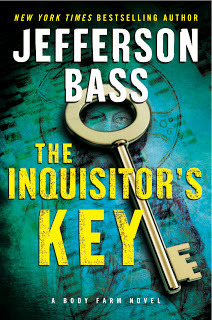
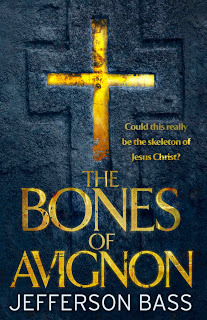 Quickly – before you read any further (no cheating!) – glance at these two book covers. If you had just enough time to take a look inside only one of them, which one would it be, and why? Hold that thought, and after you finish reading, tell us your answer in the "Comments" section. Your feedback will make for interesting market-research data!
Quickly – before you read any further (no cheating!) – glance at these two book covers. If you had just enough time to take a look inside only one of them, which one would it be, and why? Hold that thought, and after you finish reading, tell us your answer in the "Comments" section. Your feedback will make for interesting market-research data!And now, A Tale of Two Covers…
You might think that a book's title would be the first, and easiest thing to write, but you'd be wrong, at least in my experience. The first Body Farm novel's title, Carved in Bone , came fairly easily. Title number two, Flesh and Bone , was also fairly easy. But after that, they got tougher. If you've followed the series, you've probably noticed that all six of the prior novels have "bone" or "bones" in the title – a way of giving some continuity to the series, and also of underscoring the emphasis on forensic anthropology: bone-detective work. But sometimes that's been a stretch, especially with novel #5, Bones of Betrayal , which included a subplot about World War II espionage and treachery. It was one of my favorite books in the series, but my least favorite title; it seemed clunky and labored, and I've wished countless times that I'd argued more forcefully for the title I wanted, which was Fallout. But at that point we were still committed to a "bone(s)" title, so I lost the argument.
Finally we came up with The Inquisitor's Key . "Inquisitor" seemed to suggest both religion and menace; "key" seemed to hint at a mystery that needed to be unlocked. Together (we hope!) the words are intriguing without giving much away. The cover art, I think, does a nice job of suggesting both the medieval religious backstory (thanks to the face framed by the oval of the key) and the modern-day setting of the main narrative (thanks to the glossy newness of the key). So that's the skinny on the U.S. title and cover.
Meanwhile (such a handy word for storytellers, "meanwhile"!), work was proceeding apace on the British edition, which actually, for the first time ever, comes out shortly before the American edition. London is quite a bit closer to France, and to Avignon; the U.K. publisher felt reasonably confident that Brits would know where Avignon was, and wouldn't be put off by the pronunciation. So although we offered the revised U.S. title, the U.K. publisher, Quercus (publisher of the year last year!) chose to stick with the original title, The Bones of Avignon . Their cover art took a more straightforward approach. It's not really a spoiler to say that the main plot revolves around a momentous question: Could the ancient skeleton found hidden in the Palace of the Popes actually be the bones of Jesus, as the inscription on the stone box seems to suggest? "Lead with your trumps" goes one time-honored piece of card-playing advice, and in their cover design, the Brits followed that advice in spades.
So, there you have it, A Tale of Two Covers.
But forget all that, and remember instead your initial, impulsive answer to the question at the top of the blog: Which of these two books would you pick up, and why? Please tell us; inquiring minds want to know!
Published on February 19, 2012 17:36
February 11, 2012
Babylon-on-the-Rhone: Avignon
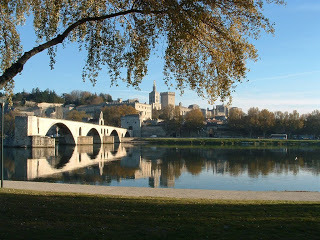
The treasures of the Vatican didn't remotely prepare me for the awesomeness of Avignon, the spectacular setting of The Inquisitor's Key and its (virtually identical) UK twin, The Bones of Avignon .
The year was 1998. I'd recently started writing and producing documentaries for A&E, the Arts & Entertainment Network, and I'd just been handed the best of projects and the worst of projects: a two-hour A&E special about the Vatican. Cool subject; gorgeous footage; serious script problems. Three other writer/producers had already come to grief on the shoals of the project; it was a high-budget, high-stakes, and high-likelihood-of-failure gig. The production company I was working for, an ambitious young outfit called Jupiter Entertainment, had somehow wrangled a backstage pass to shoot in the Vatican, but the shoot had to be done quickly. There was no shooting script; there wasn't even an outline for the show. The initial crew was sent to Rome with instructions to "shoot everything." The only plan was to figure out a plan later, once the footage was in hand.
But the footage we had—somewhere in the neighborhood of a hundred hours of footage—didn't add up to the script I'd written, so we begged for (and got) Vatican permission to go back briefly. We shot in catacombs. Roman ruins. The Vatican Library. The Vatican Museums. On the way home, almost as an afterthought, we made a quick side trip to a small city in southern France—Avignon—which I'd never heard of before this project. (Growing up Protestant in a small town in Alabama, I hadn't exactly been steeped in papal history.) During the 1200s and early 1300s, I learned, Italy was ravaged by a deadly feud between two factions, the Guelphs and Gibellines (imagine the Hatfields and the McCoys wearing tights, speaking Italian, and wielding daggers rather than shotguns). So when a French pope was elected in 1305, the French king "suggested" the pope come to France, and the papacy relocated to a town in Provence called Avignon. And there it stayed for much of the 1300s—a sojourn called the Babylonian Captivity by critics.
Avignon was strategically located, at one end of southern France's only bridge across the Rhone. When Pope Clement V arrived in 1309, he commandeered the local bishop's palace—cramped, makeshift quarters in which Clement and two successors made do, until 1334. In that year—while still claiming that the papacy was in Avignon "temporarily"—Pope Benedict XII began work on more spacious quarters. Avignon grew by leaps and bounds, its population soaring from about 3,000 in 1309 to some 50,000 in 1348.
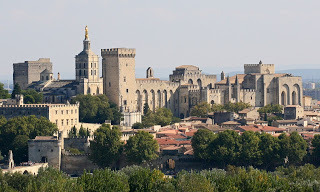 When I arrived in Avignon in 1998, camera crew in tow, I was blown away. We came to shoot in the "Palace of the Popes" … but the structure that loomed high above us was not so much a palace as an impregnable fortress, protected by massive towers and soaring battlements. And in keeping with the pope's status as God's go-to guy on earth, it was big. How big? The biggest Gothic castle in Europe. The papal court at Avignon, I learned, cost 10 times what the royal court of France cost to run.
When I arrived in Avignon in 1998, camera crew in tow, I was blown away. We came to shoot in the "Palace of the Popes" … but the structure that loomed high above us was not so much a palace as an impregnable fortress, protected by massive towers and soaring battlements. And in keeping with the pope's status as God's go-to guy on earth, it was big. How big? The biggest Gothic castle in Europe. The papal court at Avignon, I learned, cost 10 times what the royal court of France cost to run. For a small-town boy from Alabama, Avignon was eye-popping. After two days of shooting—in the immense audience hall, the cathedral-sized "private" chapel, the fresco-filled walls, the heavily fortified treasure chamber—I left Avignon bewitched and bedazzled. I've got to come back someday, I thought. I'm not finished here yet; don't wanna be, anyhow.
Thirteen years later, in the spring of 2011, I returned. No camera crew this time; just my lovely, smart wife … and an idea for a crime novel that would link the majesty, mystery, and power-plays of medieval Avignon with modern-day murder and forensic science. What if a mysterious set of bones was found in the Palace of the Popes, I thought, hidden there in the 14th century – bones that could be the archaeological find of the millennium? Who might be dying—or who might be killing—to lay their hands on those bones?
People often ask writers, "Where do you get your ideas?" For The Inquisitor's Key, I got the idea—though it took years to gestate in my subconscious—there within the ancient city walls and beneath the looming battlements of Avignon.
Published on February 11, 2012 17:26
February 5, 2012
The Road to Avignon … and to The Inquisitor’s Key
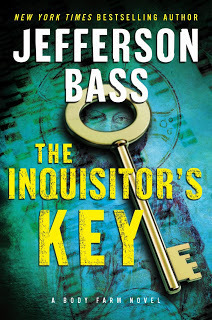 My mother cried when I announced, at the end of my freshman year in college, that I was changing my major from pre-med to English. “But how will you make a living?” she wailed.
My mother cried when I announced, at the end of my freshman year in college, that I was changing my major from pre-med to English. “But how will you make a living?” she wailed.I shrugged. “I don’t know,” I conceded. “But I’m pretty smart. I’ll probably figure out something.”
Over the years, that “something” has ranged from editing technical reports to teaching teenagers about sex and HIV/AIDS to making television documentaries about aircraft carriers and Vatican art treasures. Now, years later – jaw-droppingly many years later – I’ve just finished writing The Inquisitor’s Key, the seventh crime novel in the Body Farm series. More about the book momentarily, because it’s my favorite of the bunch, and it’s the reason I’m launching this blog – to share behind-the-scenes stories with readers between now and when the book comes out on May 8. But first, a bit of background on the series itself.
The Body Farm series is published under the pen name “Jefferson Bass”: my last name + the last name of Dr. Bill Bass, my scientific collaborator on the books. Bass is a forensic anthropologist – a bone detective – best known for creating the Body Farm. Officially (and boringly) called the Anthropology Research Facility, the Body Farm is the world’s first and foremost laboratory devoted to the study of postmortem human decay.
Yes, postmortem human decay. Decomposition. Decomp. Shuffling off this mortal coil. Or – to borrow a phrase from musician George Clinton, the king of funk – “maggot brain.” Memento mori and carpe diem: nothing like a visit to the Body Farm to make you appreciate the swiftness and sweetness of life. Take your own virtual visit to the Body Farm here.
I first walked through the Body Farm’s weathered wooden gate in 2000, as I was researching a television documentary about the facility’s scientific research and its contributions to solving crimes. Three acres of hillside covered with oak trees, maples, and dogwoods, the Body Farm is tucked behind the University of Tennessee Medical Center in Knoxville. For the past 30 years, forensic anthropology professors and graduate students have been putting donated bodies on the ground – and in the ground, and in water, and in the trunks and backseats of cars, &c., &c. – and studying what happens: how long it takes, in these crime-like settings, for bodies to turn to skeletons. In winter, nothing much happens (think of a slab of pork ribs in a refrigerator); in the muggy heat of an East Tennessee summer, though, bacteria and bugs can devour the soft tissue in just 10 days or so.
The Body Farm serves several purposes. First, the data from the decomp experiments helps forensic scientists give police accurate time-since-death estimates whenever a decaying body is found at a death scene. Second, the bones from the donated bodies go into a skeletal collection – the largest collection of modern, known skeletons in the U.S., maybe in the world. That skeletal collection (which now includes more than a thousand skeletons) is a valuable teaching tool, and the detailed measurements from the bones are entered in the Forensic Data Bank and used by ForDisc, a computer program that can determine the sex, race, and stature of an unknown crime victim – a John Doe or Jane Doe – even if only a few bones of the victim are found. Third, the Body Farm is a unique training facility for law-enforcement agencies and other groups, such as the FBI’s Evidence Recovery Teams.
During the television documentary project that prompted my first visit to the Body Farm – when I wrote and produced two one-hour shows for National Geographic – I became friends with Bill Bass. So when Bass asked if I’d be interested in writing a book with him about his career, I thought, Sure – sounds fascinating! And it was. I enjoyed channeling Bass, and the book – Death’s Acre – got good reviews in the U.S. and the United Kingdom; it’s been translated and published in around 15 countries so far.
Although Death’s Acre was nonfiction, it got me thinking about fiction. Many of the “heroes” in crime novels are dark, tortured souls – people you wouldn’t even want to chat with at a cocktail party, much less accompany down the dark alleys of the human soul. But Bass – a guy who’d spent years up to his elbows in death and dismemberment – struck me as one of the sunniest, cheeriest folks I’d ever met. So I asked Bass if he’d be willing to let me pitch a novel inspired by him and the Body Farm. He agreed, but added skeptically, “I’m not sure anybody will be interested in reading it.” An editor at William Morrow contracted for three novels, and so – with Bass providing the forensic expertise and me providing the stories – “Jefferson Bass” and the Body Farm novels were born.
Luckily, Bass’s skepticism about the novels proved wrong: Five of the six already in print have been New York Times bestsellers, though we’ve yet to crack the top ten. I’m hoping that will change with novel #7, because I LOVE this book. The U.S. edition is titled The Inquisitor’s Key; the U.K. title is The Bones of Avignon. By either title, the book draws on remarkable subject matter, weaving together a shocking present-day murder with a sinister medieval mystery – all of it unfolding against one of the most astonishing backdrops of history, art and architecture I’ve ever seen: Avignon, France, a walled medieval gem of a city that’s dominated by the Palace of the Popes, the biggest Gothic palace in all of Europe.
The Bones of Avignon comes out in Britain on April 26; The Inquisitor’s Key in the U.S. on May 8. Between now and then, this blog will give behind-the-scenes glimpses of medieval and modern Avignon; the inquisitor who became a pope; the medieval mystic who inspired one of today’s biggest self-help gurus; the labyrinthine Palace of the Popes; the haunting and controversial Shroud of Turin; the quest to use genetic engineering to trigger the Apocalypse; and other book-related sneak peeks and inside scoops.
Stay tuned!
Published on February 05, 2012 09:32
The Road to Avignon … and to The Inquisitor's Key
 My mother cried when I announced, at the end of my freshman year in college, that I was changing my major from pre-med to English. "But how will you make a living?" she wailed.
My mother cried when I announced, at the end of my freshman year in college, that I was changing my major from pre-med to English. "But how will you make a living?" she wailed.I shrugged. "I don't know," I conceded. "But I'm pretty smart. I'll probably figure out something."
Over the years, that "something" has ranged from editing technical reports to teaching teenagers about sex and HIV/AIDS to making television documentaries about aircraft carriers and Vatican art treasures. Now, years later – jaw-droppingly many years later – I've just finished writing The Inquisitor's Key, the seventh crime novel in the Body Farm series. More about the book momentarily, because it's my favorite of the bunch, and it's the reason I'm launching this blog – to share behind-the-scenes stories with readers between now and when the book comes out on May 8. But first, a bit of background on the series itself.
The Body Farm series is published under the pen name "Jefferson Bass": my last name + the last name of Dr. Bill Bass, my scientific collaborator on the books. Bass is a forensic anthropologist – a bone detective – best known for creating the Body Farm. Officially (and boringly) called the Anthropology Research Facility, the Body Farm is the world's first and foremost laboratory devoted to the study of postmortem human decay.
Yes, postmortem human decay. Decomposition. Decomp. Shuffling off this mortal coil. Or – to borrow a phrase from musician George Clinton, the king of funk – "maggot brain." Memento mori and carpe diem: nothing like a visit to the Body Farm to make you appreciate the swiftness and sweetness of life. Take your own virtual visit to the Body Farm here.
I first walked through the Body Farm's weathered wooden gate in 2000, as I was researching a television documentary about the facility's scientific research and its contributions to solving crimes. Three acres of hillside covered with oak trees, maples, and dogwoods, the Body Farm is tucked behind the University of Tennessee Medical Center in Knoxville. For the past 30 years, forensic anthropology professors and graduate students have been putting donated bodies on the ground – and in the ground, and in water, and in the trunks and backseats of cars, &c., &c. – and studying what happens: how long it takes, in these crime-like settings, for bodies to turn to skeletons. In winter, nothing much happens (think of a slab of pork ribs in a refrigerator); in the muggy heat of an East Tennessee summer, though, bacteria and bugs can devour the soft tissue in just 10 days or so.
The Body Farm serves several purposes. First, the data from the decomp experiments helps forensic scientists give police accurate time-since-death estimates whenever a decaying body is found at a death scene. Second, the bones from the donated bodies go into a skeletal collection – the largest collection of modern, known skeletons in the U.S., maybe in the world. That skeletal collection (which now includes more than a thousand skeletons) is a valuable teaching tool, and the detailed measurements from the bones are entered in the Forensic Data Bank and used by ForDisc, a computer program that can determine the sex, race, and stature of an unknown crime victim – a John Doe or Jane Doe – even if only a few bones of the victim are found. Third, the Body Farm is a unique training facility for law-enforcement agencies and other groups, such as the FBI's Evidence Recovery Teams.
During the television documentary project that prompted my first visit to the Body Farm – when I wrote and produced two one-hour shows for National Geographic – I became friends with Bill Bass. So when Bass asked if I'd be interested in writing a book with him about his career, I thought, Sure – sounds fascinating! And it was. I enjoyed channeling Bass, and the book – Death's Acre – got good reviews in the U.S. and the United Kingdom; it's been translated and published in around 15 countries so far.
Although Death's Acre was nonfiction, it got me thinking about fiction. Many of the "heroes" in crime novels are dark, tortured souls – people you wouldn't even want to chat with at a cocktail party, much less accompany down the dark alleys of the human soul. But Bass – a guy who'd spent years up to his elbows in death and dismemberment – struck me as one of the sunniest, cheeriest folks I'd ever met. So I asked Bass if he'd be willing to let me pitch a novel inspired by him and the Body Farm. He agreed, but added skeptically, "I'm not sure anybody will be interested in reading it." An editor at William Morrow contracted for three novels, and so – with Bass providing the forensic expertise and me providing the stories – "Jefferson Bass" and the Body Farm novels were born.
Luckily, Bass's skepticism about the novels proved wrong: Five of the six already in print have been New York Times bestsellers, though we've yet to crack the top ten. I'm hoping that will change with novel #7, because I LOVE this book. The U.S. edition is titled The Inquisitor's Key; the U.K. title is The Bones of Avignon. By either title, the book draws on remarkable subject matter, weaving together a shocking present-day murder with a sinister medieval mystery – all of it unfolding against one of the most astonishing backdrops of history, art and architecture I've ever seen: Avignon, France, a walled medieval gem of a city that's dominated by the Palace of the Popes, the biggest Gothic palace in all of Europe.
The Bones of Avignon comes out in Britain on April 26; The Inquisitor's Key in the U.S. on May 8. Between now and then, this blog will give behind-the-scenes glimpses of medieval and modern Avignon; the inquisitor who became a pope; the medieval mystic who inspired one of today's biggest self-help gurus; the labyrinthine Palace of the Popes; the haunting and controversial Shroud of Turin; the quest to use genetic engineering to trigger the Apocalypse; and other book-related sneak peeks and inside scoops.
Stay tuned!
Published on February 05, 2012 09:32
Jefferson Bass's Blog
- Jefferson Bass's profile
- 1155 followers
Jefferson Bass isn't a Goodreads Author
(yet),
but they
do have a blog,
so here are some recent posts imported from
their feed.



